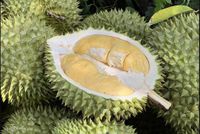In the first quarter of 2025, Vietnam's merchandise exports reached a remarkable $102.84 billion USD, marking a 10.6% increase compared to the same period last year. This growth reflects a robust performance across various sectors, with the domestic economic sector contributing $29.02 billion USD, a 15.0% increase that accounted for 28.2% of total export turnover. Meanwhile, the foreign-invested sector, which includes crude oil, achieved $73.82 billion USD, a 9.0% increase, making up 71.8% of the total exports.
Notably, 18 items surpassed the $1 billion USD mark in export turnover, collectively accounting for 84.5% of total exports. Among these, five items exceeded $5 billion USD, contributing to 59.9% of the total export value.
On the flip side, merchandise imports in the same quarter reached $99.68 billion USD, which is a significant 17.0% increase compared to the previous year. The domestic economic sector's imports totaled $36.78 billion USD, up 19.3%, while the foreign-invested sector imported $62.9 billion USD, marking a 15.8% increase.
In terms of high-value imports, electronics, computers, and components accounted for a staggering $31.6 billion USD, reflecting a 31.5% increase. Additionally, machinery, equipment, tools, and spare parts contributed $12.6 billion USD, up 22.1%.
When examining trade relationships, the United States emerged as Vietnam's largest export market, with turnover reaching $31.4 billion USD. In contrast, China was the largest import market, with a turnover of $38.1 billion USD. The trade surplus with the United States reached $27.3 billion USD, up 22.1% from the previous year, while the surplus with the EU was $9.9 billion USD, a 15.7% increase. Notably, the trade surplus with Japan saw a remarkable increase, reaching $0.6 billion USD, which is more than five times higher than the same period in 2024.
Conversely, imports from China surged to $24.9 billion USD, a 43.3% increase, while imports from South Korea and ASEAN reached $7.1 billion USD and $3.8 billion USD, reflecting increases of 14.4% and 83.2%, respectively.
Overall, the merchandise trade balance for the first quarter of 2025 recorded a surplus of $3.16 billion USD, a decrease from the $7.7 billion USD surplus reported in the same quarter of the previous year. The domestic economic sector experienced a trade deficit of $7.76 billion USD, while the foreign-invested sector achieved a surplus of $10.92 billion USD.
Looking back at the earlier months, total import-export turnover in February 2025 reached $63.77 billion USD, marking a 0.7% increase compared to January and a 32.6% increase year-on-year. In January, the turnover between Vietnam and the United States hit $11.1 billion USD, while the overall import-export turnover for that month was $63.15 billion USD, reflecting a 10.5% decrease from December and a 3.5% decrease year-on-year.
Prime Minister Pham Minh Chinh has directed Deputy Prime Minister Ho Duc Phoc and relevant agencies to review and prepare specific negotiation plans with the United States. He emphasized that while the U.S. is the largest export market for Vietnam, it is not the only one, highlighting the opportunity to restructure the export market and enhance the quality of goods to penetrate other lucrative markets.
In a different sector, the durian fruit, once a leader in Vietnam's fruit export market, is facing significant challenges. In the first two months of 2025, the export value of durian plummeted to nearly $52.7 million USD, a staggering 69% decrease compared to the same period last year. Particularly concerning is the 83% drop in exports to China, the largest market for durian, which fell to just $27 million USD. As a result, durian has slipped to third place in the export rankings, behind dragon fruit and bananas.
Despite this downturn, there are glimmers of hope. Exports of durian to Hong Kong and Taiwan skyrocketed, increasing 31 times and 74 times respectively, reaching $3.7 million USD and $1.34 million USD. Exports to the U.S. also saw a slight increase, totaling nearly $1.2 million USD, up 8.3% from the previous year, maintaining its position as the fifth-largest market for Vietnamese durian.
According to Dang Phuc Nguyen, Secretary General of the Vietnam Fruit and Vegetable Association, the primary reason for the sharp decline in durian exports is stringent control measures from China and other markets. China has tightened inspections for the presence of a carcinogenic compound known as gold O, leading to many shipments being held up and forcing businesses to sell at lower domestic prices. The U.S. has also ramped up controls, banning seven pesticide active ingredients and requiring farm codes from the U.S. Department of Agriculture. Meanwhile, Europe has increased its pesticide residue inspection rate from 10% to 20%, adding further pressure on Vietnamese fruit exports.
Domestically, many farmers are struggling to manage cadmium levels, while packaging facilities face challenges in post-harvest preservation. The durian market is becoming increasingly polarized, with well-managed farms that meet food safety standards able to sell at higher prices, while smaller, less organized farms are forced to accept much lower prices.
As of April 7, 2025, the purchasing price for Ri6 durian type A at local markets fluctuated around 75,000 VND per kilogram, while types C and D were priced between 35,000 - 40,000 VND per kilogram. Large purchasers, like Manh Khuong, a major buyer in the Mekong Delta, stated that he only sources from long-established farms that adhere to proper cultivation techniques.
While the South Korean and Japanese markets maintain stable demand, challenges remain with China. Currently, most of the durian purchased is supplied to the domestic market, keeping prices relatively stable without significant fluctuations. However, businesses are optimistic that with stronger exports of frozen durian to China, the market may see positive changes. Especially during the peak season from June to October, export volumes could surge, giving this fruit a chance to reclaim its leading position in the export fruit sector.
The first batch of frozen durian from Vietnam was exported to China on March 24, 2025, weighing 24 tons and executed by Nam Do Agricultural Products Company from Krong Pak district, Dak Lak province. This milestone follows the signing of a protocol between the Ministry of Agriculture and Rural Development and the General Administration of Customs of China on August 19, 2024, which opened the door for the official export of frozen durian.






